Synthetic Fuel Market Research, 2031
The global synthetic fuel market was valued at $3.9 billion in 2021 and is projected to reach $22.5 billion by 2031, growing at a CAGR of 19.7% from 2022 to 2031.
Report key highligters:
- The synthetic fuel market has been analyzed in terms of value (billion) covering more than 15 countries.
- For growth prediction, we have looked into historical trends including present and future activities of key business players.
- The report covers detailed profiling of the major 10 market players
Synthetic fuels are chains of elements hydrogen and carbon also known as hydrocarbon molecules. It is also known as synfuel. They are made by capturing carbon emissions during the process of manufacture. The carbon captured during the process can be further used as raw material for producing gasoline, diesel, and natural gas. It can replace petrol without any modification to the engine. These fuels exhibit the same properties as fossil fuels. Synthetic fuels are produced by mimicking the same process as fossil fuels but through renewable resources. They can be transported and stored in the same way as conventional fuels. They can also use carbon dioxide from the atmosphere and offset the emissions from vehicles.
Synthetic fuel is believed to be an alternative to fossil fuels in the future energy economy. Since the fuel production process will be capturing carbon dioxide during the process and be fed for further production of fuels, many industry players are investing in enhancing the existing synthetic fuel and boosting research and development activities.
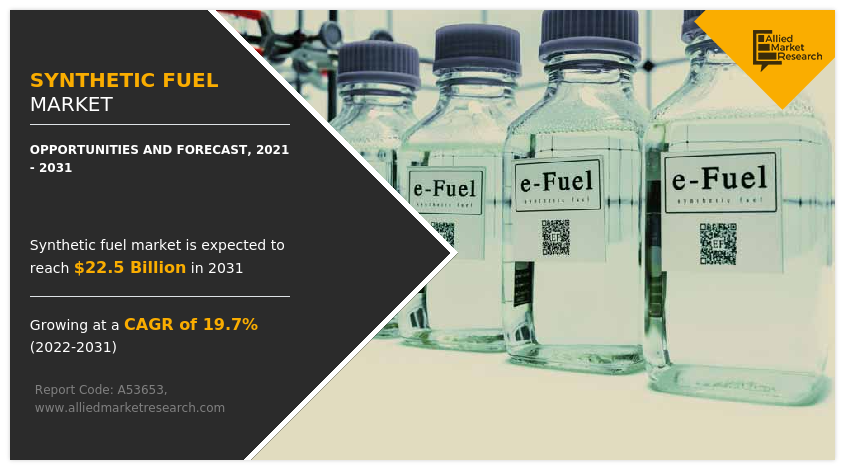
Synthetic fuel produces the same energy output in the same volume as fossil fuel. Experts consider synthetic fuel to be carbon neutral. Arguably, synthetic fuel uses carbon dioxide from the atmosphere which is more or less equal to the carbon dioxide produced by the combustion process. Synthetic fuel can be truly net-zero in cases where the production process of the fuel is free from carbon emission that is through renewable resources.
Bosch, a global player in synthetic fuels, estimates that to achieve climate targets, globally, CO2 emissions from traffic alone must be reduced by 50% in the span of the next 40 years, and by at least 85% in advanced economies. Synthetic fuels can be deployed in the existing infrastructure such as vehicles, fuel stations, and storage.
Synthetic fuel production process:
A mixture of carbon monoxide and hydrogen is known as syngas. Syngas is turned into liquid fuel through an industrial process similar to fossil fuels. Instead of using coal or natural gas as feedstock, it uses energy from renewable resources such as solar, wind, hydro, and/or biomass. The carbon dioxide used in the process is directly captured from the atmosphere or from other industrial processes.
The synfuel market growth is driven by the diversification of the primary energy mix. Industry players and the government are looking for alternatives that will help in reducing carbon footprints as well as offer similar or enhanced performance compared to fossil fuels. Moreover, market growth is also being encouraged by investments that are increasing and boosting research and development activities.
Furthermore, the continuous pursuit to reduce carbon emissions also acts as a driving factor for the synthetic fuel industry. However, the cost of synthetic fuel is more than that of conventional fuels and thus acts as a restraint to the growth of the synthetic fuel industry. Moreover, the availability of potential alternative fuels such as hydrogen fuel cells and biofuels hamper the market growth for synthetic fuels.
The sources for primary energy are majorly fossil fuels followed by renewable sources followed by other sources that have very low contributions towards the energy mix. However, the ever-growing carbon emissions from human activities such as industrialization, transportation, and others have led to an increase in the temperature of the earth causing climate changes.
Carbon dioxide is considered a major contributor to this climate change and hence all economies across the globe are acting to reduce their carbon footprint. In the essence of this, capturing carbon from the atmosphere and producing fuel for use in various applications is one of the suitable ideas to curb carbon emissions or even to set off existing carbon emissions.
In recent years, many corporations and industry players are entering into collaborations or joint ventures for researching the possibilities of synthetic fuels. They are even collaborating with automobile and aviation giants to promote synthetic fuel. Aston Martin, Porsche, Ford, Aramco, Bosch, and other market leaders are working with startups or research firms to encourage synthetic fuel use. This will also save many classic automobile models such as Mazda, Mustang, and others from going fully electric through a sustainable option. This results in increased investment in research and development activities, further acting as a growth driver for the synthetic fuel market.
There is increased demand for electric vehicles as they have successfully shown the importance of switching to an electric mode of transportation. Using battery-operated vehicles which contribute zero amounts of greenhouse gases to the environment is in huge demand. The automobile sector is launching fully electric versions of many popular models as well as new ones to meet the demand and cut down on carbon emissions. Thus, the growing market for electric vehicles overshadows the synthetic fuel benefits and thus hampers the synthetic fuel market growth. Moreover, the presence of alternate fuels also discourages synthetic fuel market opportunities.
Many high-end technologies are used for capturing carbon and producing hydrogen. After getting the desired carbon dioxide and hydrogen they are made to react together and form hydrocarbon chains. There is a huge industrial process behind this which incurs a high cost for production. Thus, the end product obtained is at the higher end of the price range. Therefore, the high cost of synthetic fuel also acts as a restraint for market growth.
Synthetic fuels have many applications in almost all industrial sectors. It can be used for firing up machinery that is currently operating on oil, gasoline, diesel, kerosene, and other such lubricants. Synthetic fuel can be used in the exact same manner as existing conventional fuels in the same infrastructure. In the automotive industry as well they can replace existing fuels in any type of engine. Similarly for the aviation industry as well the use of synthetic fuels can be used and help reduce carbon footprint. Thus, such a vast potential of fuel provides lucrative opportunities for industry growth.
The synthetic fuel market size is segmented into raw material, type, application, and region.
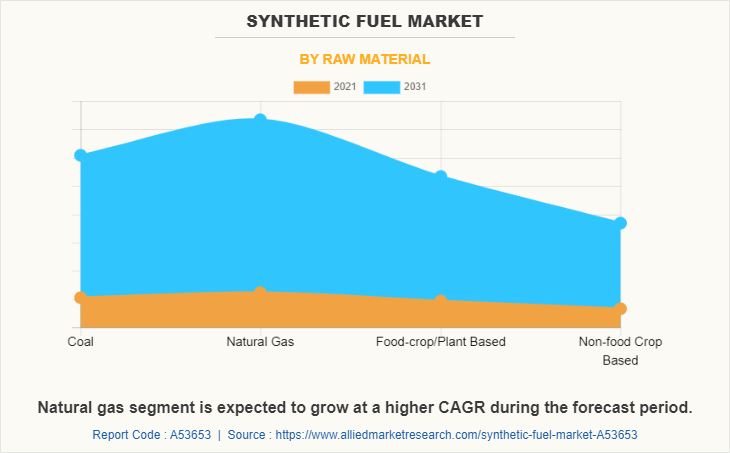
By raw material, the synthetic fuel market is divided into coal, natural gas, food-crop/plant-based, and non-food crop based. The natural gas segment is expected to grow at a higher pace. In Great Britain, for example, a combination of demand reduction increased low-carbon renewable generation, and fuel switching from coal to natural gas generation have provided an emissions reduction of 61% in 2016 from a 1990 baseline. Thus, it is expected that natural gas will be one of the major contributors to the synthetic fuel market growth followed by coal.
Biomass to liquid (BTL) fuels are obtained in similar processes like GTL and CTL. The only difference in the process is that organic material is used from wood, crops, straws, Municipal Solid Waste (MSW), and grains. Biomass is subjected to combustion in an environment with low oxygen to obtain syngas. The syngas produced is further processed into synthetic fuels. BTL fuels require a lot less energy than other synfuels.
However, it costs more money and requires a huge number of feedstocks. Moreover, it is also a lesser-known process and requires heavy investments. Meanwhile, in the long run, the process of making synthetic fuel from BTL is much more environmentally friendly and emits lower carbon dioxide. Technological advancements and boosts from government and private players can contribute to synthetic fuel market growth.
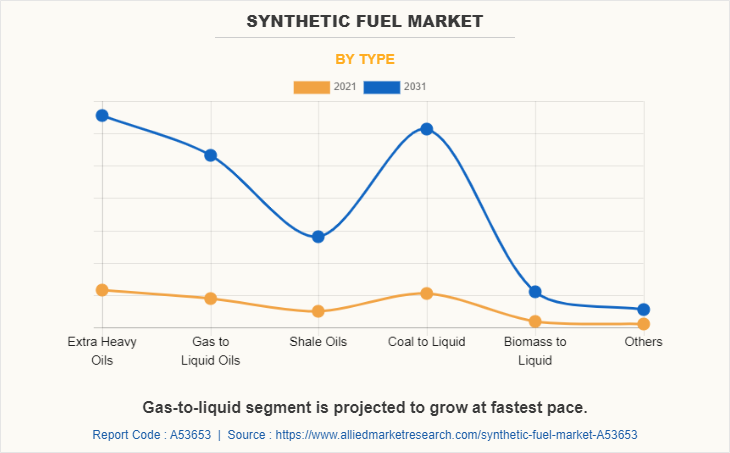
By type, the synthetic fuel market was segmented into extra heavy oils, gas to liquid oils, shale oils, coal to liquid, biomass to liquid, and others. The gas-to-liquid oils segment is projected to grow at a higher pace followed by coal-to-liquid. Coal-to-liquid (CTL) technology is practiced to convert coal into liquid fuel. It is done through Fischer-Tropsch conversion technology. Coal is subjected to pulverization and then reacted with a catalyst. After that under high pressure and temperature hydrogen is added to make hydrocarbon chains in presence of a solvent which results in raw liquid. This process results in synthetic fuel that is used in many applications such as gasoline, jet fuel, and diesel.
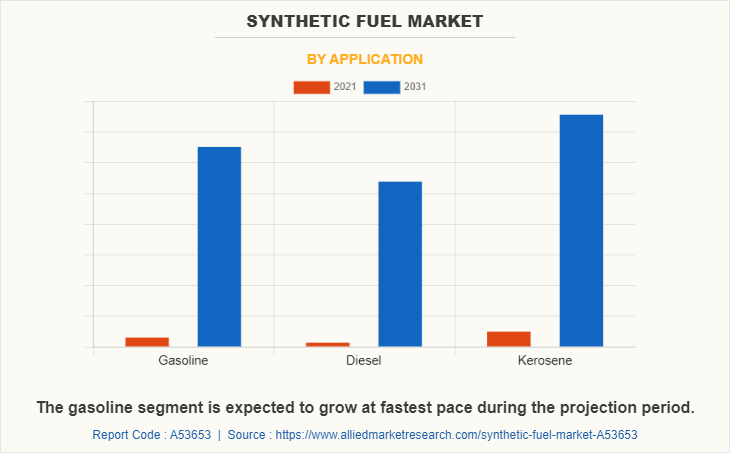
Depending on the application, the market is divided into gasoline, diesel, and kerosene. The gasoline segment is expected to grow at the fastest pace during the projection period. Gasoline is the primary source of fuel in the transportation industry. It is also used to power several industrial processes. Gasoline is a mixture of hydrocarbons used to fuel vehicles and used in major energy sources worldwide. Gasoline means gas or petrol which is used in internal combustion engines. They are also used as solvents in many industrial applications.
Turning synthetic gas into fuels is a widely used industrial process. Synthetic gasoline produced through similar industrial processes exhibits similar properties to that of conventional gasoline. It can be used in existing vehicles and engines. The fuel can also be transported, distributed, and stored through existing infrastructure. Moreover, the synthetic gasoline produced is almost carbon neutral as the production process requires carbon dioxide, which is either extracted from the atmosphere or captured by the industrial process. The carbon dioxide used in the production is said to be equivalent to the carbon emission on the road. Thus, the growing demand for synthetic gasoline will fuel the market growth for synthetic fuel.
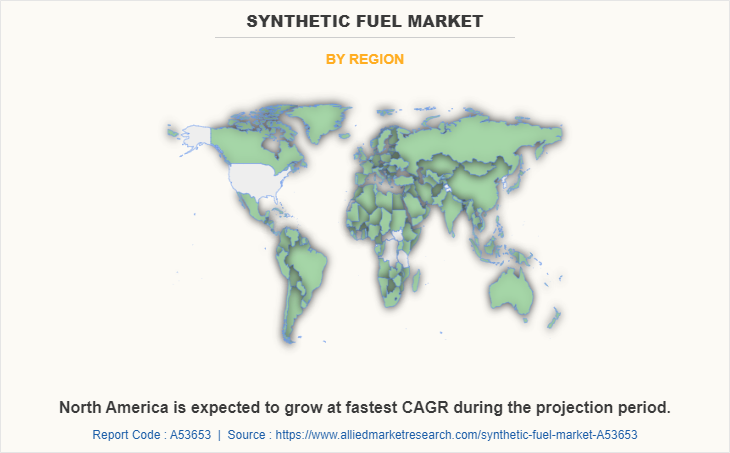
Region-wise, the synthetic fuel market analysis is done across North America, Europe, Asia-Pacific, And LAMEA (Latin America, The Middle East, and Africa). North America dominated the synthetic fuel market share for 2021 and is expected to continue its dominance during the synthetic fuel market forecast period. The synthetic fuel market growth is driven by numerous factors. In the U.S., the government has implemented strict rules and regulations to promote the applications of synthetic fuels and encourage the production of those fuels.
Moreover, the government is also investing and encouraging private players to invest in enhancing the present synthetic fuel production technology. Canada is also a major contributor to the rising demand for synthetic fuel. Moreover, the market growth is also driven due to the need to cut down carbon emissions and transition energy away from fossil fuels.
The key players operating in the synthetic fuel industry are Sasol, Indian Oil Corporation, Shell Plc, Exxon Mobil Corporation, Reliance, Robert Bosch GmbH, Air Liquide, PetroChina, Phillips 66, And SG Preston Company. Porsche (owned by Volkswagen) is investing around $100 million at a new facility in Chile which is expected to produce 13,000 liters of synthetic fuel by 2022 and by 2026 it is expected to produce 550 million liters. Similarly, BMW invested $12.5 million in an e-fuel startup.
Key Benefits For Stakeholders
- This report provides a quantitative analysis of the market segments, current trends, estimations, and dynamics of the synthetic fuel market analysis from 2021 to 2031 to identify the prevailing synthetic fuel market opportunities.
- The market research is offered along with information related to key drivers, restraints, and opportunities.
- Porter's five forces analysis highlights the potency of buyers and suppliers to enable stakeholders make profit-oriented business decisions and strengthen their supplier-buyer network.
- In-depth analysis of the synthetic fuel market segmentation assists to determine the prevailing market opportunities.
- Major countries in each region are mapped according to their revenue contribution to the global market.
- Market player positioning facilitates benchmarking and provides a clear understanding of the present position of the market players.
- The report includes the analysis of the regional as well as global synthetic fuel market trends, key players, market segments, application areas, and market growth strategies.
Synthetic Fuel Market Report Highlights
| Aspects | Details |
| Market Size By 2031 | USD 22.5 billion |
| Growth Rate | CAGR of 19.7% |
| Forecast period | 2021 - 2031 |
| Report Pages | 350 |
| By Type |
|
| By Raw Material |
|
| By Application |
|
| By Region |
|
| Key Market Players | Synhelion SA, Bosch Ltd, Reliance Industries Ltd, Sasol Limited, Exxon Mobil Corporation, Shell Plc., Indian Oil Corporation Ltd, L'Air Liquide S.A., PetroChina Company Limited, Phillips 66 Company |
Analyst Review
According to the insights from CXOs, the synthetic fuel market is highly consolidated in nature. With very few players operating in the industry, the synthetic fuel market is gaining momentum as it is experiencing a boost in research and development investments. In the continuous search for sustainable fuels, synthetic fuel offers lower to no carbon emissions and similar performance to that of conventional fuels. There are several benefits of synthetic fuels such as reduced carbon emissions and sustainable fuel economy; thus, the market is experiencing boosted investment in research and development projects. Moreover, diversification of energy mix and carbon reduction targets have led global leaders to look for opportunities offered by synthetic fuel. However, the availability of alternative fuels and the higher cost of synthetic fuels discourage the overall synthetic fuels industry growth and thus act as a constraining factor.
Kerosene is the leading application of Synthetic Fuel Market
North America is the largest regional market for Synthetic Fuel
reducing carbon emissions and progressing towards clean energy economy are the upcoming trends of the Synthetic Fuel Market in the world
The estimated industry size of Synthetic Fuel market is $22.5 billion by 2031.
Sasol, Indian Oil Corporation, Shell Plc, Exxon Mobil Corporation, Reliance, Robert Bosch GmbH, Air Liquide, PetroChina, Phillips 66, and SG Preston Company are the top companies to hold the market share in Synthetic Fuel
Loading Table Of Content...
Loading Research Methodology...



